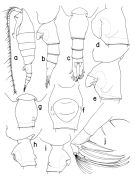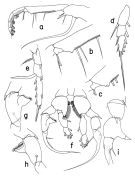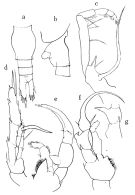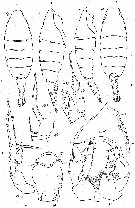|
|
 |
|
Calanoida ( Order ) |
|
|
|
Arietelloidea ( Superfamily ) |
|
|
|
Heterorhabdidae ( Family ) |
|
|
|
Heterorhabdus ( Genus ) |
|
|
| |
Heterorhabdus fistulosus Tanaka, 1964 (F,M) | |
| | | | | | | Ref.: | | | Tanaka, 1964 a (p.7, figs.F,M); Heptner, 1971 (p.149, figs.F,M, Rem.: 2 forms, tuberculata and typica); Kos, 1976 (Vol. II, figs.f,M, Rem.); Park, 2000 (p.111, figs.F,M, Rem.); Chihara & Murano, 1997 (p.818, Pl.119,120: F,M) |  issued from : T. Park in Bull. Scripps Inst. Oceanogr. Univ. California, San Diego, 2000, 31. [p.232, Fig.80]. Female: a, habitus (left side); b, c, urosome (left, dorsal , respectively); d, genital somite (left), e, genital somite with operculum open (left); f, genital somite (ventral); g, h, i, genital somite with a tubercular outgrowth (dorsal, left, right, respectively); j, left Mx2 (posterior). Nota: Prosome length 70 % length of body and about 2.2 times length of urosome. Forehead (laterally) with rounded anterior end and produced ventrad into a conical rostrum bearing 2 selender filaments. A1 extending beyond posterior end of caudal ramus by its last 1 or 2 segments. Mx2: 2nd seta of 1st lobe approximately 1/3 length of 1st seta. Posterior subterminal spine of 4th lobe 68% as long as2nd saberlike spine, which is only slightly longer than 1st. Saberlike spine of 5th lobe 83% as long as falcate spine. Genital somite with a tubercular outgrowth on dorsolateral side and close to posterior end. Genital field with 7-16 pores on left side and about 25 pores on right side. Length ratios of 4 urosomal somites and left caudal ramus 36.4 : 18.8 : 13.9 : 9.1 : 21.8 = 100.
|
 issued from : T. Park in Bull. Scripps Inst. Oceanogr. Univ. California, San Diego, 2000, 31. [p.233, Fig.81]. Female: a, right Mxp (anterior); b, distal part of basis of right Mxp (anterior); c, idem, from different specimen (anterior); d, exopod of P1 (anterior); e, exopod of P5 (posterior). Male: f, P5 (anterior); g, h, second exopodal segment of right P5 (anterior, posterior, respectively); i, exopod of left P5 (anterior).
|
 issued from : O. Tanaka in Publs Seto Mar. Biol. Lab., 1964, XII (1). [p.8, Fig.177]. Female: a, urosome (dorsal); b, last thoracic segment and genital somite (lateral left side); c, Mxp; d, P5. Nota: The urosome segments and furca are in the proportional lengths as 44:14:10:7:25 (right) = 100. The genital somite is slightly asymmetrical. A1 over-reaches the furcal rami by 2 terminal segments Male: e, right P5; f, left P5; g, 1st and 2nd segment of exopod of left P5. Nota: The urosome segments and furca are in the proportional lengths as 22:17:16:12:9:24 = 100. A1 extends to the distal margin of the anal segment.
|
 issued from : M.V. Heptner in Trudy. Inst. Okeanol., 1971, 92. [p.150, Fig.36]. Female & Male; forma tuberculata Figs. 1, 2, 5-8. Forma typica Figs. 3, 4, 9, 11.
|
 Heterorhabdus fistulosus Heterorhabdus fistulosus female: 1 - See key to species groups of Heterorhabdus: ''fistulosus'' Group (p.90, 110). 2 - Dorsally, genital somite widest in anterior half; dorsally as well as laterally, genital prominence for short of reaching posterior end of somite (Fig.80-g, h).
|
 Heterorhabdus fistulosus Heterorhabdus fistulosus male: 1 - See key to species groups of Heterorhabdus: ''fistulosus'' Group (p.90, 110). 2 - Basal inner lobe of right P5 elongate (Fig.81-f). Lateral conical process and outer spine of 2nd exopodal segment of left P5 elongate, their combined lengths approxiamtely 2/3 length of segment (Fig.81-i).
| | | | | Compl. Ref.: | | | Shimode & al., 2005 (p.113 + poster); Park & Ferrari, 2009 (p.143, Table 8, biogeography) | | | | NZ: | 3 | | |
|
Distribution map of Heterorhabdus fistulosus by geographical zones
|
| | | | Loc: | | | Japan (Izu region), Kuril-Kamchatka Trench, off N California
Type locality: Izu region (Japan).
For Park (2000, p.112), the species is apparently confined to the northern Pacific. | | | | N: | 4 | | | | Lg.: | | | (23) F: 3,95-3,5; M: 3,85-3,5; (121) F: 3,6-3,39; M: 3,45; (824) F: 3,72-3,4; M: 3,56-3,4; {F: 3,39-3,95; M: 3,40-3,85} | | | | Rem.: | meso-bathy-abyssopelagic (100-6900 m)
"Fistulosus" Group.
Park (2000, p.112) emphasizes that Hepner (1971) found 2 different types of females, one with a tibercular outgrowth on the dorsolateral side of the genital somite and another without such an outgrowth and distinguished them as H. fistulosusf. tuberculata and H. fistulosus f. typica, respectively. In Park's specimens, the tubercular outgrowth was found to vary from a small, low ridge only visible by a careful observation to a highly prominent conical process. Upon examination of 25 females with tubular processes of varying size no other morphological differences could be found. All 15 males also showed no morphological differences. | | | Last update : 10/04/2020 | |
|
|
 Any use of this site for a publication will be mentioned with the following reference : Any use of this site for a publication will be mentioned with the following reference :
Razouls C., Desreumaux N., Kouwenberg J. and de Bovée F., 2005-2025. - Biodiversity of Marine Planktonic Copepods (morphology, geographical distribution and biological data). Sorbonne University, CNRS. Available at http://copepodes.obs-banyuls.fr/en [Accessed July 11, 2025] © copyright 2005-2025 Sorbonne University, CNRS
|
|
 |
 |







